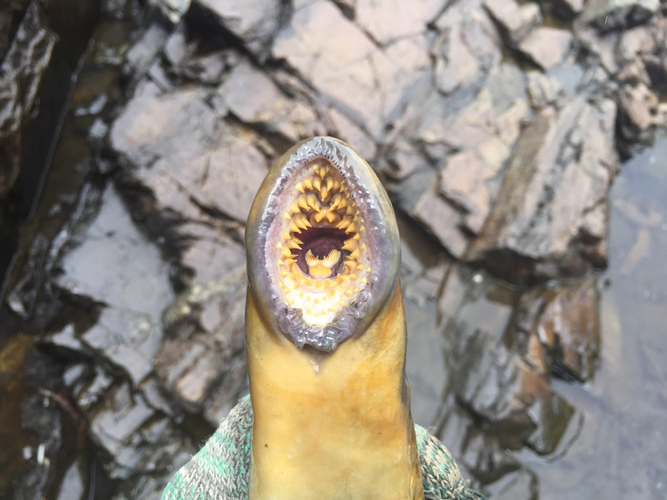WESTMINSTER — It is spring, and the upriver migrations of shad, American eel, sea lamprey, and other minor players in the migration game are getting underway.
Unfortunately, many people do not like sea lamprey - even if they have never seen one, they know they do not like it. Unfortunately, the misunderstood nature of sea lamprey in our watershed fuels the dislike.
So right from the get-go, know that we should value the sea lamprey, for it is not a parasite to our fish and, as a native fish in the Connecticut River, it is an important contributor to the balance of nature.
* * *
The sea lamprey is not an eel - it lacks the bone skeleton and hinged jaw. Adults have an internal skeleton of cartilage so, unlike our usual fish, they lack bones, jaws, and paired fins.
The lamprey's taxonomic name is Petromyzon marinus. Petromyzon translates roughly from the Latin into “one who suckles stone.”
Lamprey grow to 40 inches long. They have well-developed eyes, a single nostril on top of the head, and seven gill openings on each side of their body but no bones; hence, they are rare as fossils.
Scientists know they are evolutionary survivors, having traveled our oceans and rivers for 360 million years. They inhabit the Atlantic Ocean and the coastal rivers, from Labrador to the Gulf of Mexico.
Lampreys are anadromous fish, meaning they come to fresh water to spawn and their young return to the sea to grow into adults.
They stop feeding when they return from salt to fresh water. Only the spawning urge drives the lamprey upriver. Lampreys cannot eat, so they must live on fat reserves in their bodies. This is not a matter of choice but the result of remarkable changes inside the lamprey.
Because of those changes - among them, losing their teeth - adult sea lampreys in our river do not attack our fish.
Their landlocked cousins in Lake Champlain, on the other hand, are a menace. Lake lamprey migrate from the tributary streams into the broad lake and back. These vampire fish never do make it to salt water and therefore never undergo the internal changes of the true anadromous lamprey, so they continue to feed without letup throughout their lives in the lake and its tributaries.
* * *
Back in our watershed, up to 100,000 lampreys each year return upriver to select their spawning site by following the scent of the ammocoetes larvae now buried in the river bottom mud spawned in previous years.
The ammocoetes are not predators, since they lack the sucker mouths of adults. Ammocoetes burrow into the mud, filtering out algae, small organisms, and rotting waste as food. The larvae will remain in the streams for up to 10 years, drifting farther downstream each year and eventually migrating to the ocean.
During their three-year stay in the ocean, lamprey become parasites, rasping into the flesh and sucking the bodily fluids of fish using their sucker-like jawless mouth rimmed by cartilage, filled with rows of horny teeth and a rasplike “tongue.” Although lampreys sometimes prey on small invertebrates, they are especially fish predators. Once attached, a lamprey will severely weaken or kill its victim fish.
Being weak swimmers, lamprey use their mouths and eel-like bodies to swim their way up waterfalls. Selecting slower moving waters, they can make their way up falls by attaching themselves by mouth suction to a flat area on a stone, wiggling their bodies until they feel the flow of the water eddy and lessen, and during that small window of pulse, immediately thrust upward and attach their mouth again at a higher point on the rock face. They do so time after time after time, until they surmount the falls.
Sea lamprey build concave circular nests by thrashing their bodies to clean the sediment off a stream bottom and, if necessary, by removing one stone at a time, attaching to it through mouth suction and swimming it out of the nest. Male and female intertwine over the nest to deposit and fertilize eggs.
* * *
There are benefits to having lamprey in our river, including improving its chemical balance as a result of transport of trace elements from the ocean back upriver from whence those micronutrients originated.
Fish and marine mammals, including seals and striped bass, favor lamprey because of their high fat content. Other fish reuse lamprey nests instead of digging their own, as a silt-free, concave area is good for all fish eggs and adult fish know it.
Immediately after spawning, lamprey die and, like all things in nature, they become the base of the new food chain. Life begins again as other species feed on their carcasses.
Sea lampreys are the fish everyone loves to hate, but they are important in our watershed. In June, in any un-dammed tributary stream off the lower river below Bellow Falls, look in moving shallow water for thrashing lamprey.
Welcome them, as they are helping their species and our river. Better yet, volunteer with the Connecticut River conservancy to monitor their nests spots at bit.ly/711-lamprey.
